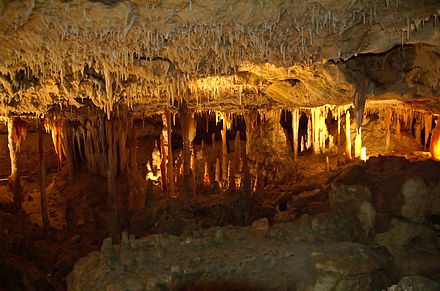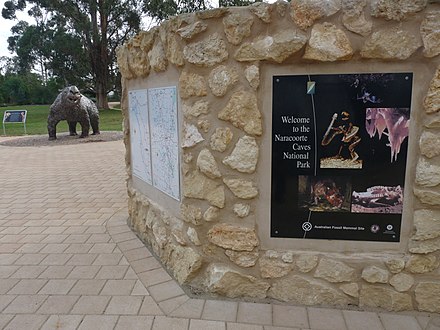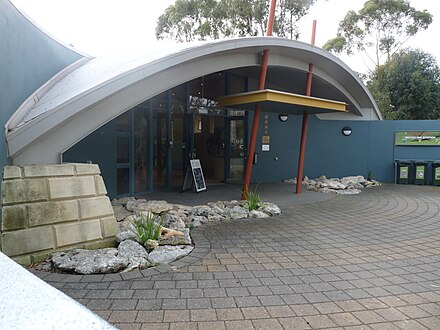Naracoorte Caves National Park - national park in Australia
 Naracoorte Caves National Park is an extraordinary paleontological site and a South Australian national park near Naracoorte, in the Limestone Coast region of South Australia. The park is a UNESCO World Heritage Site, as part of the "Australian Fossil Mammal Sites" along with Riversleigh in Queensland and as of 2022, it is the only world heritage site in South Australia.
Naracoorte Caves National Park is an extraordinary paleontological site and a South Australian national park near Naracoorte, in the Limestone Coast region of South Australia. The park is a UNESCO World Heritage Site, as part of the "Australian Fossil Mammal Sites" along with Riversleigh in Queensland and as of 2022, it is the only world heritage site in South Australia.
The caves in Naracoorte Caves National Park essentially played a role of acting like pitfall traps and these animals often fell into these openings and as they could not get out once they fell, they died once having fallen, forming fossils over time. Because Australia has been quite separate from other continents ever since it separated from Antarctica 35 million years ago, much of its marsupials have not been recorded anywhere outside of Australia or New Guinea. What's found in these caves also largely differs as well, spanning from 500,000 years ago through several ice ages to the very recent 60,000 years ago, when megafauna in Australia became extinct and the arrival of humans.
As of 2021, there are 28 known caves in the park, but only four of them are open to the public. The other 24 are used for scientific research purposes.
On top of the paleontological aspects of the park, the geological formations of the caves are also quite a view, but it also depends on which cave. Nevertheless, all of them have something unique in their own right.
Understand

History
Naracoorte Caves (which are within the park's boundaries) were first encountered in 1845, with the Blanche Cave being the first cave to be found. Not long after, after 40 years, the Department of Woods and Forests appointed a caretaker due to "the popularity of the caves and their vulnerability to vandalism" as the cave became a more popular sight.
On 27 April 1972, the park was named as the "Naracoorte Caves Conservation Park" upon the proclamation of the National Parks and Wildlife Act 1972 which repealed the former act along with other statutes concerned with conservation, and ten years later in 1982, the conservation park was listed on the now-defunct Register of the National Estate.
In December 1994, 300 hectares of the park became a UNESCO World Heritage Site, along with Riversleigh in Queensland and in January 2001, the "Naracoorte Caves Conservation Park" was abolished and the land that it occupied was reconstituted as a national park because it was considered to be "of national significance by reason of the natural features of the land" and the name, Naracoorte Caves National Park was assigned.
Today, it's one of South Australia's most visited parks, attracting visitors from all over the world, and the visitor numbers to the park have continued to rise.
Landscape
.jpg/440px-Stalactites_-_Victoria_Fossil_Cave,_Naracoorte_Caves_National_Park_(4284120183).jpg) The limestone of the area was formed from coral and marine creatures 200 million years ago and again 20 million years ago when the land was below sea level. Ground water since then has dissolved and eroded some of the limestone, creating the caves. Caves such as the Victoria Fossil Cave and Blanche Cave, are often not far below ground and holes open up creating traps for the unwary and the source of the remarkable collection of fossils.
The limestone of the area was formed from coral and marine creatures 200 million years ago and again 20 million years ago when the land was below sea level. Ground water since then has dissolved and eroded some of the limestone, creating the caves. Caves such as the Victoria Fossil Cave and Blanche Cave, are often not far below ground and holes open up creating traps for the unwary and the source of the remarkable collection of fossils.
Mammals and other land creatures have fallen into open caves and been unable to escape. The fossil record has been preserved in strata formed from eroded topsoil washed and blown in. In some places, the fossil-bearing silt is up to 20 metres thick. Some of these areas are being preserved for future research when better methods of dating and reconstructing fossil records may have been found and these fossil traps are especially significant for tracing Australian megafauna hence why this place is a jewel in Australian paleontology.
Above ground though, it's mostly just flat.
Flora and fauna
As the place is a cave, there's little flora and fauna that are alive found in the park, and most of it is found above the ground, not below the ground. As in most places, seeing a kangaroo roaming around the park is not uncommon, and so is seeing wallabies and emus. Koalas are not found here, as they need trees to survive here in the first place.
Below the ground and into the cave, there are large bat populations, which can be seen if you go on the Bat Tour or to Blanche Cave. However, their populations are declining, and it's thought to be disease that's contributing to the decline, although it's not clear why, at least, not yet.
Climate
Given that the park also goes underground, the climate of this park significantly differs. But on the ground level, much of the park's climate is warm or cool year round, and it rarely rains in the park, but the temperatures can plummet down to freezing during night, particularly in the colder months of winter and can also go and hit the high 40s during summer. There's no particular season to visit this park when it comes to climate, but if you don't want to get soaked up in the rain and avoid the cold, your best choice is outside June or July, and if you don't like the head, anytime outside January or February will do you fine.
But as always the temperature below ground is always going to well differ, and so regardless of the weather or the rainfall, the caves always have a consistent temperature of , unless of course, you're going to the Roof Top Loop Walk, in which you'll not even be heading underground. Regardless, a small jacket will do you fine, and at worst, a large jacket will make you feel warm.
Visitor information centre

- Wonambi Visitor Centre, -37.0355°, 140.7958°, +61 8 8762 2340. 9AM-5PM. In the same building as Wonambi Fossil Centre, on top of being a megafauna display, has nearly everything about the park here, including tours, accommodation, self guided walks etc. Adult: $15, concession: $13, child: $9, family (2 adults + 2 children or 1 adult + 3 children): $39.50 2021-11-13
Contact information
The contact information of the park is as follows:
- Naracoorte Caves, 89 Wonambi Road, Naracoorte, +61 8 8760 1210 (tours and camping), +61 8 8760 1201 (park administration), naracoortecaves@sa.gov.au. 9AM-5PM. 2021-11-14
This is just for the park as a whole, and so for individual aspects of the park, use the relevant details, not this one, unless there's none.
Get in
By bus
Stateliner runs regular services from Adelaide to Mount Gambier, stopping along the way at Naracoorte town centre. However from there, there's no other form of getting from the town centre to the national park, so you'll need to stop at either Mount Gambier or Keith, and rent a car from there.
If you don't know how to drive or are not comfortable driving on the left side of the road, Vear's taxis, offers long distance rides from Mount Gambier or Lake City Taxis (dead link: January 2023), also from Mount Gambier, although they don't always offer long distance services.
By car
Unlike most caves in Australia, Naracoorte Caves National Park is quite easily accessible and does not require using winding roads, but rather a straight highway used between South Australia's two largest cities; Adelaide and Mount Gambier. It's a four-hour drive from Adelaide CBD, a one hour drive from Mount Gambier, and a five-hour drive from Melbourne.
From Adelaide, it can easily be reached when heading east up on the M1 South Eastern Freeway up Adelaide Hills, passing Murray Bridge, continuing onto A8 Dukes Highway and after three hours at Keith, turn onto A66 Riddoch Highway up till Caves Road where you've then arrived. The way from Mount Gambier is more straightforward, with it just being an hour drive north via the A66 until Caves Road where you've then arrived.
Fees and permits
There are no entry fees for the park, but there are fees for the caves and visitor centre. Prices shown below, as of November 2021.
| Location | Adult | Concession | Child | Family (2 adults + 2 children <br>or 1 adult + 3 children) |
|---|---|---|---|---|
| Stick-Tomato Cave | $11 | $9 | $7 | $29 |
| Wonambi Fossil Centre | $15 | $13 | $9 | $39.50 |
| Alexandra Cave | $24 | $19.50 | $14 | $63.50 |
| Victoria Fossil Cave | $35 | $28.50 | $17 | $87 |
| Bat Tour (Bat Observation Centre and Blanche Cave) | $28 | $22 | $16.50 | $74.50 |
There are no fees for the walking trails and that includes places where you can see fossils from the top above ground, but camping fees also apply.
Get around
Above land, you get the choice of walking, or taking the car around when you're above ground, although there aren't many places to park your car, so you may as well be better off walking.
But below ground, you've got no choice but to go through a tour (guided or self-guided), well because, there's literally no other way of getting around and that's quite obvious – you're underground.
See
.jpg/440px-Naracoorte_Caves-_Victoria_Fossil_Cave_38_(26059279561).jpg)
Caves
- Alexandra Cave, -37.036221°, 140.796248°. Tours run 9:30AM and 1:30PM. This cave is mostly known for its speleothems, namely the sharp pin-like stalactites, but also for its other geological processes that have formed these caves. The tours go for around 30 minutes, starting from the fossil centre. 2021-11-14
- Bat Centre and Blanche Cave, -37.034269°, 140.796579°. 2021-11-14
- Stick-Tomato Cave, -37.036638°, 140.79754°. 9AM-5PM. The only self-guided walk that's available for you to do, this cave is possibly the quickest and easiest cave to do, particularly if you've got limited time or small children. The cave has two chambers to explore and is also well lit with an automated lighting system. Suitable for all ages, and the most physical requirement you'll need to do this self guided walk is if you can walk twenty steps. Adult: $11, concession: $9, child: $7, family: $29 2021-11-14
- Victoria Fossil Cave, -37.04716°, 140.803199°. Tours run 10:15AM and 2:15PM. It's this cave that makes the entire park a massive tourist spot, and why the park had been recognised by UNESCO for its value. It's a one hour tour, and you'll be passing through numerous chambers, and more on excavation techniques, accumulation of bones in the caves, research and world heritage. The place was only found in 1969, when two explorers squeezed through a gap and found the remains that they did. 2021-11-14
Other points of interests
- Wonambi Fossil Centre (Wonambi Visitor Centre), -37.0357°, 140.7956°, +61 8 8762 2340. 9AM-5PM. A fossil centre that shows you how the caves worked, and how there were pitfall traps, dens and roosts for more than 500,000 years bringing in the vast skeletal selection it has today. Adult: $15, concession: $13, child: $9, family (2 adults + 2 children or 1 adult + 3 children): $39.50 2021-11-13
Do
Buy
The only shops apart from the cafe in the park is located in the fossil centre/visitor centre where souvenirs are sold. Apart from the visitor centre, there are no shops in the park. The nearest can be found in the nearby town of Naracoorte.
Eat

- Caves Cafe, Unnamed Road, -37.036163°, 140.7966°, +61 8 8760 1213. M-Sa 10AM-3PM, Su 9:30AM-3PM. Peak visitor times (SA school holidays/public holidays): 9:30AM-4PM. Popular with the locals, and whether its a snack or lunch, this cafe is perfect given its close proximity to the caves. 2021-10-20
Drink
- Wrattonbully, Caves Rd, Naracoorte, -37.033646°, 140.793971°, +61 409 520 778, info@wrattonbullywineregion.com. Another one of the South Australia's world class wine producers, this winery has about 50 grape growers and 20 wine producers with a large variety of wine. The more unusual fact is that this is the only winery on a UNESCO World Heritage Site. 2021-11-13
Sleep
Lodging
- Wirreanda Bunkhouse, 43 Caves District Rd, Joanna, -37.042311°, 140.801148°. A dormitory-style accommodation which can accommodate 49 people with rooms of four, six or eight. Generally advised for large groups. 2021-11-13
Camping
Backcountry
You can't go camping outside of designated areas, and this park is very small in the first place, so unfortunately, you cannot go backcountry camping in this park.
Stay safe
Go next
Your only choices are to either
- head north to Naracoorte town centre, or up to Keith leading to the two state capitals of Adelaide and Melbourne
- head south to South Australia's second largest city, Mount Gambier, the cave diving capital of Australia
Related: Paleontology in Australia
Related: Nilpena Ediacara National Park
Related: Boodjamulla National Park
Related: Ikara-Flinders Ranges National Park
Naracoorte Caves National Park
South Australia
Primary administrative division